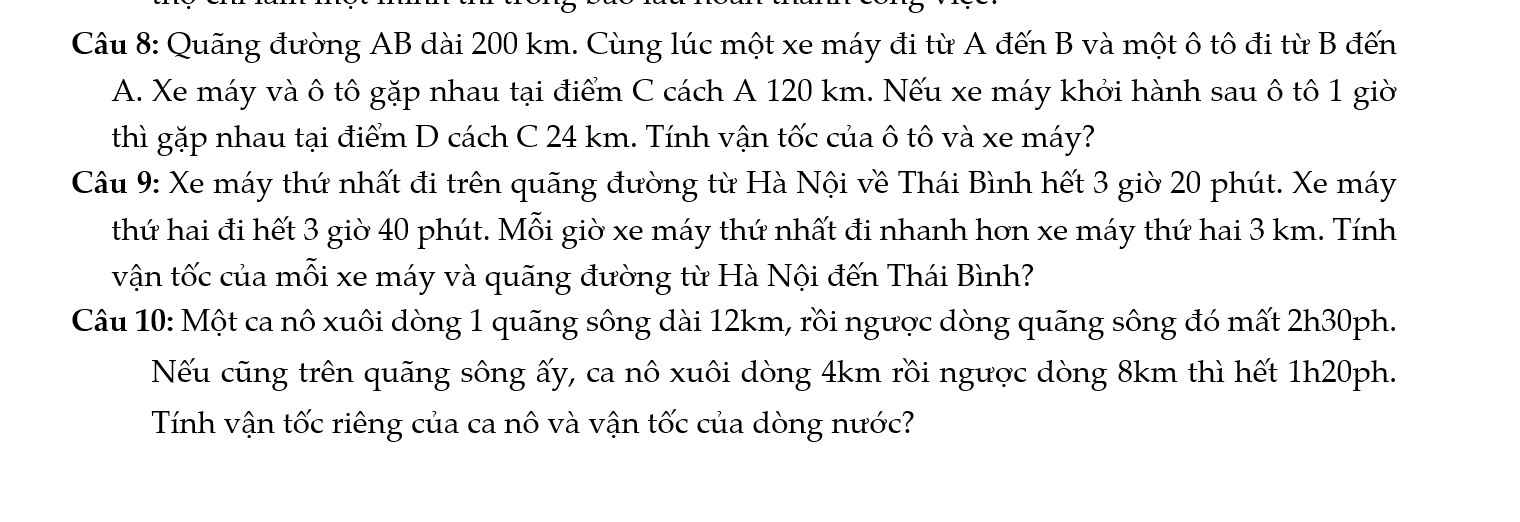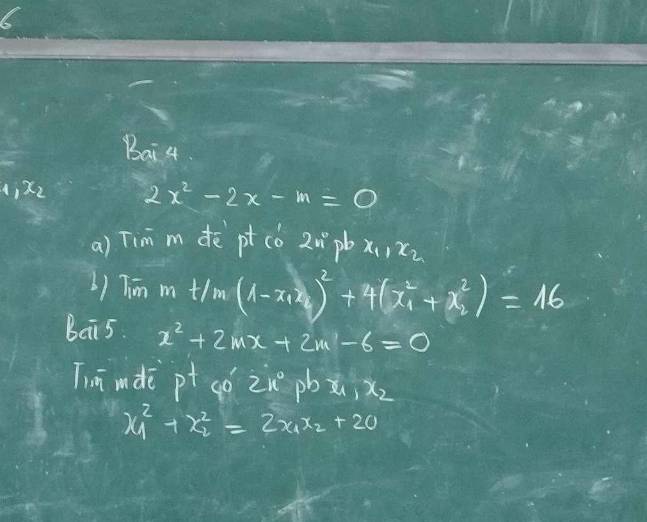
Hãy nhập câu hỏi của bạn vào đây, nếu là tài khoản VIP, bạn sẽ được ưu tiên trả lời.


\(\left\{{}\begin{matrix}x+y=900\\1,15x+1,1y=1010\end{matrix}\right.< =>\left\{{}\begin{matrix}1,1x+1,1y=990\\1,15x+1,1y=1010\end{matrix}\right.\)
\(< =>\left\{{}\begin{matrix}-0,05x=-20\\x+y=900\end{matrix}\right.< =>\left\{{}\begin{matrix}x=400\\y=500\end{matrix}\right.\)


\(\Leftrightarrow\left\{{}\begin{matrix}\dfrac{1}{3}x+\dfrac{1}{3}-\dfrac{1}{4}y-\dfrac{1}{2}-\dfrac{2}{5}x+\dfrac{2}{5}y=0\\\dfrac{1}{4}x-\dfrac{3}{4}-\dfrac{1}{3}y+1-2y+x=0\end{matrix}\right.\)
\(\Leftrightarrow\left\{{}\begin{matrix}-\dfrac{1}{15}x+\dfrac{3}{20}y=\dfrac{1}{6}\\\dfrac{5}{4}x-\dfrac{7}{3}y=-\dfrac{1}{4}\end{matrix}\right.\Leftrightarrow\left\{{}\begin{matrix}-4x+3y=10\\15x-28y=-3\end{matrix}\right.\)
\(\Leftrightarrow\left\{{}\begin{matrix}-60x+45y=150\\60x-112y=-12\end{matrix}\right.\Leftrightarrow\left\{{}\begin{matrix}y=\dfrac{138}{67}\\x=\dfrac{1221}{335}\end{matrix}\right.\)

Để hệ vô nghiệm thì
\(\dfrac{2m-1}{m+3}\ne\dfrac{5}{1}\\ \Leftrightarrow2m-1\ne5\left(m+3\right)\\ \Leftrightarrow m\ne-\dfrac{16}{3}\)
\(\dfrac{2m-1}{m+3}=\dfrac{3}{-4}\left(m\ne-3\right)\\ \Leftrightarrow-4\left(2m-1\right)=3\left(m+3\right)\\ \Leftrightarrow m=-\dfrac{5}{11}\left(tm\right)\)

a: Khi m=-1 thì hệ sẽ là:
x-y=11 và 5x-3y=0
=>x=-33/2 và y=-55/2
b: Để hệ có nghiệm duy nhất thì 1/5<>-m/3
=>m/-3<>1/5
=>m<>-3/5

Lời giải:
Từ ĐKĐB suy ra:
$-x^2+5xy+2y^2=3(x^2+y^2)$
$\Leftrightarrow 4x^2-5xy+y^2=0$
$\Leftrightarrow 4x(x-y)-y(x-y)=0$
$\Leftrightarrow (4x-y)(x-y)=0$
$\Rightarrow 4x=y$ hoặc $x=y$.
Nếu $4x=y$. Thay vô PT $(1)$ thì:
$x^2+(4x)^2=1\Rightarrow x=\pm \frac{1}{\sqrt{17}}$
$\Rightarrow x=\pm \frac{4}{\sqrt{17}}$ (tương ứng)
Trường hợp $x=y$ tương tự, ta tìm được $(x,y)=(\pm \frac{1}{\sqrt{2}}; \pm \frac{1}{\sqrt{2}})$


Bài 5:
\(x^2+2mx+2m-6=0\)
\(\text{Δ}=\left(2m\right)^2-4\left(2m-6\right)\)
\(=4m^2-8m+24\)
\(=4m^2-8m+4+20\)
\(=\left(2m-2\right)^2+20>=20>0\forall m\)
=>Phương trình luôn có hai nghiệm phân biệt
Theo Vi-et, ta có:
\(\left\{{}\begin{matrix}x_1+x_2=-\dfrac{b}{a}=\dfrac{-2m}{1}=-2m\\x_1x_2=\dfrac{c}{a}=\dfrac{2m-6}{1}=2m-6\end{matrix}\right.\)
\(x_1^2+x_2^2=2x_1x_2+20\)
=>\(\left(x_1+x_2\right)^2-2x_1x_2-2x_1x_2=20\)
=>\(\left(-2m\right)^2-4\left(2m-6\right)=20\)
=>\(4m^2-8m+24-20=0\)
=>\(4m^2-8m+4=0\)
=>\(\left(2m-2\right)^2=0\)
=>2m-2=0
=>2m=2
=>m=1(nhận)
Câu 4:
a: \(2x^2-2x-m=0\)
\(\text{Δ}=\left(-2\right)^2-4\cdot2\cdot\left(-m\right)\)
\(=4+8m\)
Để phương trình có hai nghiệm phân biệt thì 8m+4>0
=>8m>-4
=>\(m>-\dfrac{1}{2}\)
b: Theo Vi-et, ta có:
\(\left\{{}\begin{matrix}x_1+x_2=\dfrac{-b}{a}=\dfrac{-\left(-2\right)}{2}=\dfrac{2}{2}=1\\x_1x_2=\dfrac{c}{a}=\dfrac{-m}{2}\end{matrix}\right.\)
\(\left(1-x_1x_2\right)^2+4\cdot\left(x_1^2+x_2^2\right)=16\)
=>\(\left(1+\dfrac{m}{2}\right)^2+4\cdot\left[\left(x_1+x_2\right)^2-2x_1x_2\right]=16\)
=>\(\left(\dfrac{m+2}{2}\right)^2+4\left[1^2-2\cdot\dfrac{-m}{2}\right]=16\)
=>\(\dfrac{1}{4}\left(m^2+4m+4\right)+4\left(1+m\right)=16\)
=>\(\dfrac{1}{4}m^2+m+1+4+4m-16=0\)
=>\(\dfrac{1}{4}m^2+5m-11=0\)
=>\(m^2+20m-44=0\)
=>(m+22)(m-2)=0
=>\(\left[{}\begin{matrix}m+22=0\\m-2=0\end{matrix}\right.\Leftrightarrow\left[{}\begin{matrix}m=-22\left(loại\right)\\m=2\left(nhận\right)\end{matrix}\right.\)
5.
\(\Delta'=1+2m\)
a.
Phương trình có 2 nghiệm pb khi:
\(1+2m>0\Rightarrow m>-\dfrac{1}{2}\)
b.
Khi pt có 2 nghiệm, theo hệ thức Viet: \(\left\{{}\begin{matrix}x_1+x_2=1\\x_1x_2=-\dfrac{m}{2}\end{matrix}\right.\)
\(\left(1-x_1x_2\right)^2+4\left(x_1^2+x_2^2\right)=16\)
\(\Leftrightarrow\left(1-x_1x_2\right)^2+4\left(x_1+x_2\right)^2-8x_1x_2=16\)
\(\Leftrightarrow\left(1+\dfrac{m}{2}\right)^2+4.1^2+4m=16\)
\(\Leftrightarrow\dfrac{m^2}{4}+5m-11=0\Rightarrow\left[{}\begin{matrix}m=2\\m=-22< -\dfrac{1}{2}\left(loại\right)\end{matrix}\right.\)
5.
\(\Delta'=m^2-\left(2m-6\right)=\left(m-1\right)^2+5>0;\forall m\)
Pt luôn có 2 nghiệm pb
Theo hệ thức Viet: \(\left\{{}\begin{matrix}x_1+x_2=-2m\\x_1x_2=2m-6\end{matrix}\right.\)
\(x_1^2+x_2^2=2x_1x_2+20\)
\(\Leftrightarrow\left(x_1+x_2\right)^2=4x_1x_2+20\)
\(\Leftrightarrow4m^2=4\left(2m-6\right)+20\)
\(\Leftrightarrow m^2-2m+1=0\Rightarrow m=1\)

\(\hept{\begin{cases}\left(x+1\right)+\sqrt{x}+\sqrt{y+1}=2\\\left(y+1\right)+\sqrt{y}+\sqrt{x+1}=2\end{cases}}\) ĐK: \(\hept{\begin{cases}x\ge0\\y\ge0\end{cases}}\)
Lấy pt (1) - (2) Ta được
\(\left(x+1\right)-\left(y+1\right)+\sqrt{x}-\sqrt{y}+\left(\sqrt{y+1}-\sqrt{x+1}\right)=0\)
\(\Leftrightarrow\left(x-y\right)+\left(\sqrt{x}-\sqrt{y}\right)+\frac{\left(y+1\right)-\left(x+1\right)}{\sqrt{y+1}+\sqrt{x+1}}=0\)
\(\Leftrightarrow\left(\sqrt{x}-\sqrt{y}\right)\left(\sqrt{x}+\sqrt{y}\right)+\left(\sqrt{x}-\sqrt{y}\right)-\frac{\left(\sqrt{x}-\sqrt{y}\right)\left(\sqrt{x}+\sqrt{y}\right)}{\sqrt{y+1}+\sqrt{x+1}}=0\)
\(\Leftrightarrow\left(\sqrt{x}-\sqrt{y}\right)\left(\sqrt{x}+\sqrt{y}+1-\frac{\sqrt{x}+\sqrt{y}}{\sqrt{y+1}+\sqrt{x+1}}\right)=0\)





a.
\(\Leftrightarrow\left\{{}\begin{matrix}\left(2x-3y\right)\left(2x-y\right)=0\\6x^2+7xy-5y^2=0\end{matrix}\right.\)
TH1: \(2x-3y=0\Rightarrow y=\dfrac{2}{3}x\) thay vào pt dưới
\(\Rightarrow6x^2+7x.\left(\dfrac{2}{3}x\right)-5\left(\dfrac{2}{3}x\right)^2=0\)
\(\Leftrightarrow\dfrac{76}{9}x^2=0\Rightarrow x=0\Rightarrow y=0\)
TH2: \(2x-y=0\Rightarrow y=2x\)
Tương tự ta cũng được \(x=0;y=0\)
Vậy hệ có nghiệm duy nhất \(\left(x;y\right)=\left(0;0\right)\)
b.
\(\Leftrightarrow\left\{{}\begin{matrix}13x^2-39xy+13y^2=-13\\2x^2+xy+3y^2=13\end{matrix}\right.\)
Cộng vế với vế
\(\Rightarrow15x^2-38xy+16y^2=0\)
\(\Leftrightarrow\left(x-2y\right)\left(15x-8y\right)=0\)
\(\Rightarrow\left[{}\begin{matrix}x=2y\\x=\dfrac{8}{15}y\end{matrix}\right.\)
Thay vào pt đầu:
- Với \(x=2y\Rightarrow4y^2-6y^2+y^2=-1\)
\(\Rightarrow y^2=1\Rightarrow\left[{}\begin{matrix}y=1\Rightarrow x=2\\y=-1\Rightarrow x=-2\end{matrix}\right.\)
- Với \(x=\dfrac{8}{15}y\)
\(\Rightarrow\left(\dfrac{8}{15}y\right)^2-3\left(\dfrac{8}{15}y\right).y+y^2=-1\)
\(\Leftrightarrow-\dfrac{71}{225}y^2=-1\Rightarrow y^2=\dfrac{225}{71}\)
\(\Rightarrow\left[{}\begin{matrix}y=\dfrac{15}{\sqrt{71}}\Rightarrow x=\dfrac{8}{\sqrt{71}}\\y=-\dfrac{15}{\sqrt{71}}\Rightarrow x=-\dfrac{8}{\sqrt{71}}\end{matrix}\right.\)